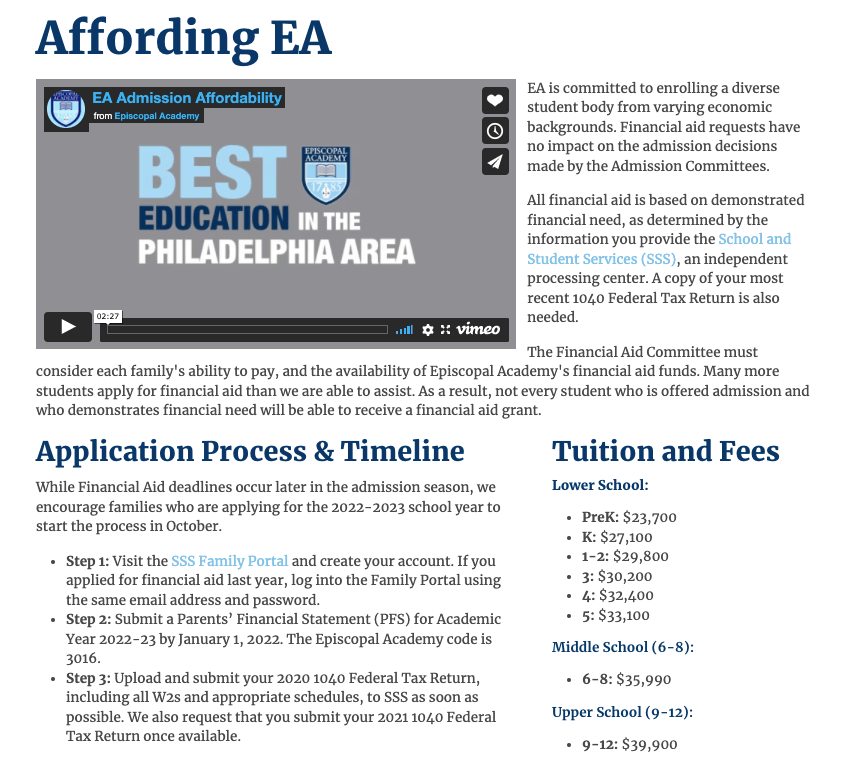Maggie Dugery ‘23 | Sarah Kotapka ‘23
A primary consideration of parents when deciding whether or not to send their children to Episcopal is its affordability. Thanks to EA’s abundant financial aid program, this concern is, often, alleviated.
The logistics of the financial aid process are fairly straightforward: when a student applies to EA, their application is considered need-blind, differentiating Episcopal from many of its peer schools in the area. After acceptance, new students’ financial situations are evaluated by Carolyn Polley, Associate Director of Admission and Director of Financial Aid, and there is a conversation about how much a family can afford in tuition payment. Polley provides insight on the intricacies of the program, commenting, “I’m the only one who sees who applies, but financial aid evaluation is done after they’re admitted. So it’s really nice since some schools do have to take the tuition revenue that’s generated into consideration when doing this. They have to take into consideration how much somebody can pay, but we don’t have to do that.”
Riley Thibodeau ‘23 believes what Polley lays out is positive, noting, “I think that need-blind admissions is important because it means that a student’s financial situation won’t be a factor when deciding whether or not they get accepted, which helps to ensure that qualified applicants–regardless of socioeconomic status–are given a more fair chance of acceptance.” She adds, “This policy and financial assistance as a whole, is super important because it enables more equity and diversity in the admissions process, helping to expand the accessibility of opportunities at EA to a greater breadth of families.”

Photo courtesy of episcopalacademy.org
Polley also discloses that Episcopal “gives out roughly eight and a half million dollars each year in financial aid.” For reference, this value is about 213 students worth of full-freight tuition, though the financial aid that is given out is not normally full tuition coverage.
Financial aid comes from a multitude of monetary sources, including alumni donations, fundraisers, and the endowment draw, which, according to Polley, “collects a certain amount of interest that comes to the operating revenue for the school… and some of that is directly allocated towards financial aid. The rest is provided by the school.”
She adds, “I want to give a shout out to Dr. Locke because he has done a tremendous job fundraising for us. When he fundraises and the endowment grows, that means the draw off of the endowment for financial aid grows. So has Larry Capuzzi, who’s our CFO. He has done a really good job of prioritizing financial aid into the budget.”
The funding is the first, and largest, step in this process; next families requiring financial aid use a third-party system called School and Student Services, where they upload taxes and other financial information. The program uses this information to generate how much aid the family will need.
The discussion continues from there to settle on an agreement, but there can sometimes be discrepancies. Polley notes, “What we think a family can afford and what they think they can afford sometimes are two different things.” She continues, “So if they want to try to look for more money, they can go to banks and try to get student loans, but there’s nothing else that the Academy provides other than the financial aid.”
While the financial aid process at EA seems straightforward, other schools sometimes function much differently. Malvern Prep, for instance, uses a different service when they can’t meet the needs of an applying student. Their website provides details: “Unfortunately, Financial Aid funds are limited and we are unable to meet the needs of all qualified applicants. The Sallie Mae K-12 Family Education Loan Program helps families continue to look for financially responsible ways to pay for private K-12 education… [it] is an ideal solution for families who need flexibility beyond financial aid, personal savings, or monthly payment plans when paying for private school education.”
Similarly, Notre Dame is unable to provide financial aid for all students. Their website states, “As funds are limited, the Academy is not able to meet 100% of demonstrated need for admitted students.”
Gaeli Keffer Scharpf ‘23 commends Episcopal’s financial commitment, saying, “I think that EA’s capacity to leverage its financial resources to provide aid to all students with demonstrated need, unlike other schools, helps make access to EA more inclusive and available.”
Another key difference between the financial aid program at EA and other schools is that EA does not offer scholarships in addition to financial aid. Polley comments on these differences in approach, explaining, “Some of our competitor schools will give money for academics, for the arts, for athletics. Sometimes they have a test just to get into their school… like Malvern, for instance, they have a test to get into their school. And if you score high enough, you get a certain amount of dollars, but we don’t do that to ensure everything is a level playing field here.”
By not offering scholarships, EA equalizes the chances for incoming applicants and searches for the best overall student, not just the best in one area of talent. In the future, donations and fundraising’s support in financial aid ventures will continue to play a large role in making up EA’s student body. As of right now, Polley discloses, “over 25% of the whole school here at EA is part of the financial aid program in some way… and we haven’t yet had a situation where we couldn’t fund somebody after they already got in.”
Erin Bilbao, Upper School Spanish Teacher and Chair of the Modern Languages Department, believes it is crucial for EA to continue its financial aid program, noting, “Financial aid is important to create and maintain the diversity of our student population. Within our community, it allows us to be more inclusive and make this experience more accessible.”